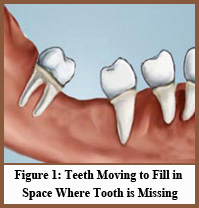Dental Implants
Dental implants are changing the way people live. They are designed to provide a foundation for replacement teeth that look, feel, and function like natural teeth. The person who has lost teeth regains the ability to eat virtually anything, knowing that teeth appear natural and that facial contours will be preserved. Patients with dental implants can smile with confidence.
More than 30 million Americans are missing all of their teeth in one or both jaws. By the age of 74, 26% of adults have lost all of their permanent teeth. 69% of adults, ages 35 to 44, have lost at least one permanent tooth as a result of an accident, gum disease, a failed root canal or tooth decay. Although there are a number of restorative options for the treatment of missing teeth, none have proven to be as functionally effective and durable as dental implants. In many cases, dental Implants may be the only logical choice for the restoration of all necessary teeth and supporting structures.
- Tooth decay
- Root canal failure
- Gum Disease
- Trauma to the mouth
- Excessive wear and tear
- Inherited defects
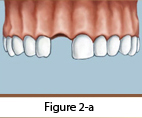
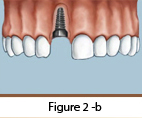
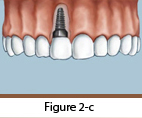
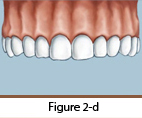
Step 1: We will do a thorough Oral Examination and address the situation that your General Dentist has referred you for. This may include but may not be limited to:
- Review your dental and medical history
- Dental exam
- Bite evaluation
- Height and width of your jawbones are measured
- Anatomic structures are identified (nerve positions and sinus proximity)
- Dental x-rays
- 3 dimensional bone scans
Step 2: We may have to prepare the area where your tooth is missing prior to placing the implant. This could include removal of excess gum tissue or bone, reshaping or rebuilding the bone.
Step 3: We will place the implant in your jaw and allow it to anchor and heal to the jaw bone. This process (Osseointegration) usually takes about 3 – 6 months (See Figure 2-b). A temporary tooth can be placed in your mouth while your implant heals.
Step 4: Once the implant has anchored to your jaw bone, the permanent false tooth can be placed over the implant by your Dentist (See Figures 2-c & 2-d). In denture cases, your General Dentist will attach the denture to the implants.
Dental Implants have been utilized for over 30 years. Studies have consistently shown success rates above 95%.
Because Dental Implants bond to your bone, crowns attached to your Dental Implants look and act similar to natural teeth. When brushing and flossing your Dental Implants you must use the proper techniques that you use on your natural teeth. In some cases, the doctors may prescribe a special daily mouth rinse for you. If you do not keep your mouth in good shape, your implants can fail.


